Development
A New Exoplanet & Interstellar Messenger | Update 20.3
Nov 21st
Run Steam to download Update 20.3, or buy Universe Sandbox ² via our website or the Steam Store.
Update 20.3 features two new simulations for the recently discovered exoplanet, Ross 128 b, and the first observed interstellar visitor, ‘Oumuamua. This update also includes a number of smaller improvements and bug fixes.
Ross 128 b
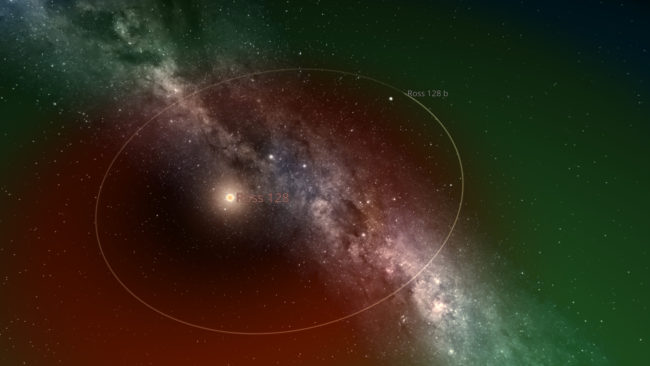
On November 15, 2017 astronomers with the European Southern Observatory (ESO) discovered Ross 128 b, a potentially habitable, Earth-sized exoplanet orbiting a red dwarf star 11 light years away.
Though Ross 128 b is farther than the closest temperate planet, Proxima b, it orbits a “quieter” red dwarf that emits far less deadly ultraviolet and X-ray radiation. This makes it a much better candidate for habitability.
See Ross 128 b in Universe Sandbox ²:
Home > Open > Ross 128 with Earth-sized Planet
‘Oumuamua
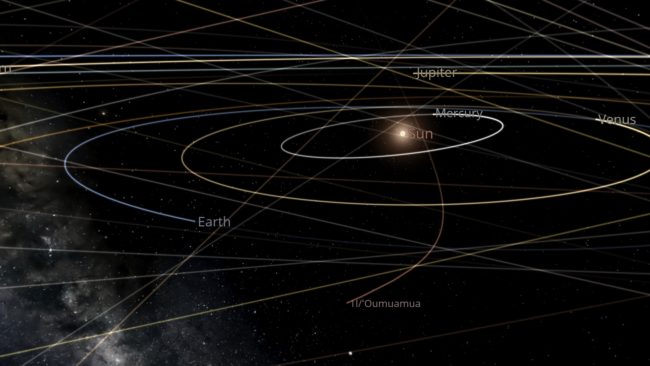
On October 19, 2017, astronomers in Hawaii observed an asteroid soaring past Earth. Analysis of its trajectory revealed that it is the first interstellar object ever observed in our solar system. Nicknamed ‘Oumuamua, meaning “a messenger from afar arriving first,” the asteroid carries the story of a distant star system born a long time ago.
Learn more about ‘Oumuamua on NASA’s website.
See ‘Oumuamua in Universe Sandbox ²:
Home > Open > Oumuamua in 2017
Check out the full list of What’s New in Update 20.3.
The New Dynamic Bottom Bar
Nov 17th
We improved the bottom bar of the user interface in our last few updates. Now when you change the width of the Universe Sandbox ² application window, the bar automagically resizes. Buttons that don’t fit are grouped into a More button, and if the window is narrow enough, the bar adapts to two rows. (Please note that this design is a work in progress and likely to change in future versions.)
It’s a small touch, and you may not think it’s that useful at first, as you probably won’t be resizing your window too often. But the portrait-style ratio of the window at the end of the video above may look familiar, and that’s because it’s very similar to your smartphone.
This dynamic resizing tech is extremely useful for Universe Sandbox ² on mobile devices. Use it in portrait mode or flip your phone sideways and use it in landscape — everything shifts and resizes seamlessly.
Thanks to our mobile developer, Dave, for all of his great work on Universe Sandbox ²!
Sign up to be notified when Universe Sandbox ² is available on mobile!
Cassini’s Limitations in Universe Sandbox ²
Sep 28th
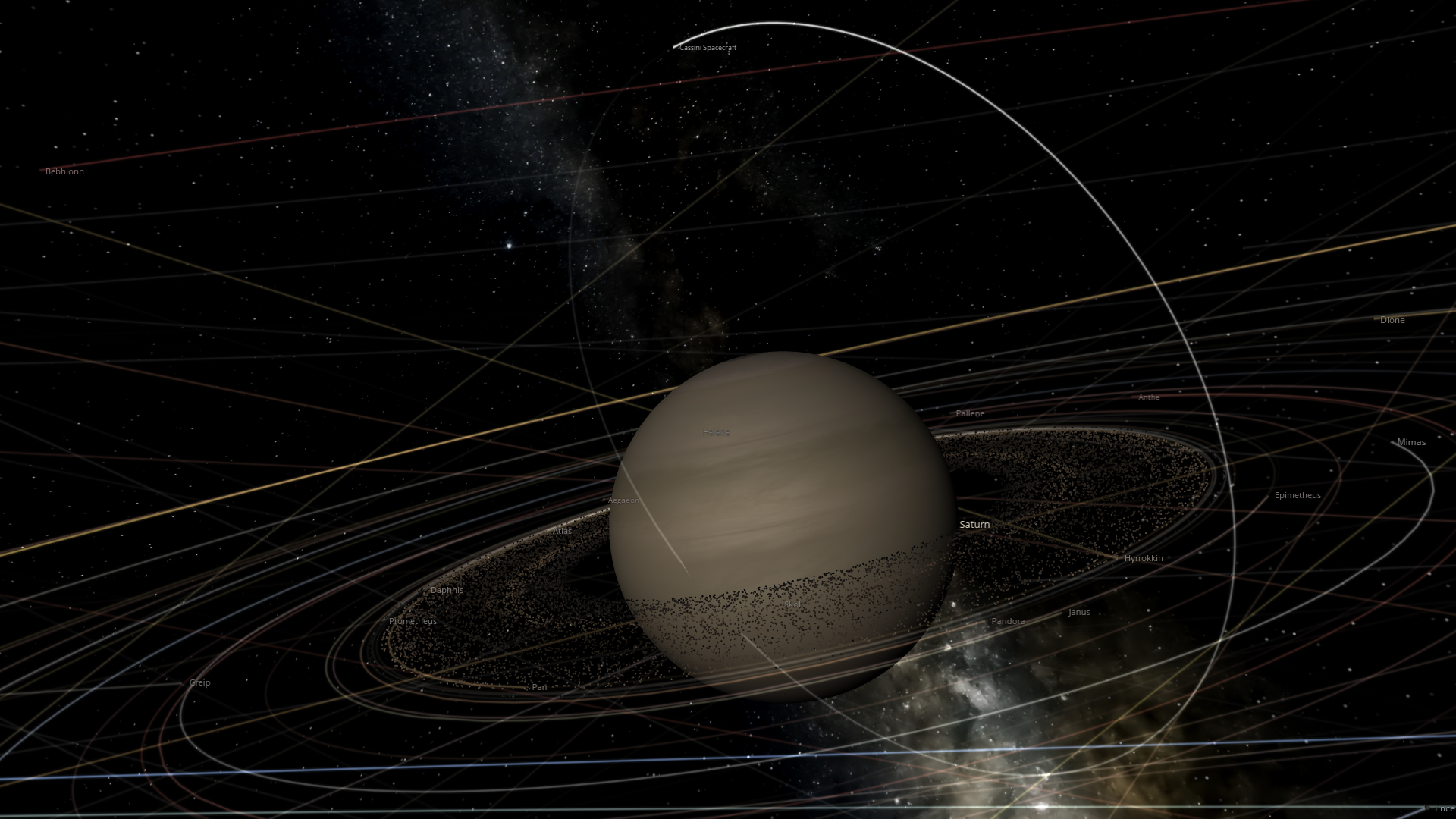
It’s been two weeks now since we said goodbye to the Cassini spacecraft. After its 20-year-long mission in space, it was running low on fuel, so NASA directed it toward Saturn in order to eliminate the risk of it contaminating the moons. On September 15, 2017, Cassini sent its final image back to Earth before disintegrating in Saturn’s atmosphere.
To commemorate this event, we released Ciao, Cassini | Update 20.2 which featured a simulation of Cassini’s final hours and collision with Saturn.
See Cassini’s final hours in Universe Sandbox ²:
Home > Open > Core/Historical > Cassini collision with Saturn on September 15, 2017
Home > Tutorials > Science > What Is Cassini’s Grand Finale?
Simulation Limitations
We had initially been wary of including a simulation of this event, as there are several limitations in Universe Sandbox ² that reduce the realism of this particular simulation. In the end, however, we decided it was still an informative and interesting visualization of an event that is very important to science and the world.
But instead of brushing these limitations under the rug, we’d like to take a closer look at them.
1 – Atmospheric Entry
We love collisions in Universe Sandbox ². But just because an object is on a collision course with a planet, that doesn’t mean it should actually collide with that planet in every scenario. If it’s small enough, then it should instead disintegrate in the planet’s atmosphere. This is what happened to Cassini as it entered Saturn’s atmosphere.
Universe Sandbox ² doesn’t yet simulate the forces associated with atmospheric entry, like atmospheric drag and aerodynamic heating. So instead, small objects will simply collide with planets. We’re very interested in simulating these effects in Universe Sandbox ², not just for objects like Cassini, but also for meteoroids that should burn up in an atmosphere, creating meteors or “shooting stars.”

An animation from Wikipedia of a meteoroid losing material as it enters Earth’s atmosphere
2 – Rocket Engines & Spacecraft Flight
Cassini didn’t stay in orbit around Saturn for 13 years, weaving through its rings and doing close flybys of its moons, all by the grace of gravity. No, its trajectory was carefully planned by engineers and frequently adjusted with its rocket engines. But while Universe Sandbox ² has models of various spacecraft, it doesn’t yet include any way to simulate or control propellant. You can manually change an object’s velocity, but you can’t apply a force to it in the same way that a rocket engine would.
We’re still a while away from controlling thrust on spacecraft and flying them through simulations in Universe Sandbox ², but we’re taking steps in that direction with our work on rigid body physics. This new tech will better simulate the physics of smaller-scale objects, such as spacecraft, allowing for precise collisions and parts that can be attached with breakable joints and other constraints.
3 – Minimum Size for Impact Visuals
When the Shoemaker–Levy 9 fragments collided with Jupiter, observers from Earth could see marks on Jupiter that were more easily visible than the famous Great Red Spot. Some of these fragments were larger than one kilometer in diameter. The Cassini spacecraft, on the other hand, was only about 6.8 meters high and 4 meters wide. Its disintegration in Saturn’s atmosphere should not be easily visible, and even if it were to collide with Saturn instead of disintegrating, it should not leave a large impact mark. [Our Cassini update added a quick fix for this problem to disable an impact mark for its collision.]
Unfortunately, in Universe Sandbox ², impact marks have a minimum visual size. This minimum size is much larger than it should be for small asteroids and human-sized objects. The alternative is to not show any impact mark at all, but that can also be unsatisfactory. There are technical reasons for this limitation, but let’s not worry about those, because there’s good news…
We are currently working on a new system which will allow for impact marks and craters of any size, no more minimum. And on top of that, the new system will be a lot faster, too, and scale to the system resolution, which should help lower-end hardware a lot.
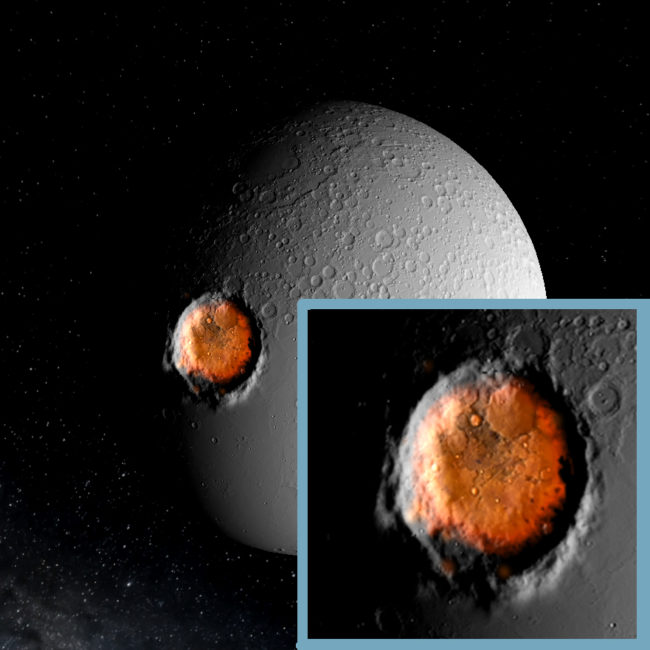
Work-in-progress screenshot of the new impact visuals in Universe Sandbox ²/span>
Opportunities, Not Limitations
The first rule of self-criticism (which we didn’t follow above) is that it’s necessary to throw things in a positive light. Drawbacks, weaknesses, limitations — they’re all opportunities for improvement! Often times these simulations of historical events are great tests of the simulation. When we put in the known properties and velocities for a set of bodies, does the simulation play out similarly to how it did in observed reality? If something is different, how can we improve the simulation in order to achieve the same results? But if instead it’s remarkably similar, as it sometimes is, then we can give ourselves a nice pat on the back and sit back and relax… Until we load a different simulation and notice another opportunity for improvement. We often say that building a universe simulator is never a completed job. A big chunk of that lies within our commitment to continuously notice where we can improve, and then take the necessary steps to make these improvements.
The above items are all on our to-do list, though we can’t promise when they will be added to Universe Sandbox ². Learn more about what we’re working on in our 2017 Roadmap.
For the latest Universe Sandbox ² news, follow us on Twitter and Facebook.
Ciao, Cassini | Update 20.2
Sep 14th

Run Steam to download Update 20.2, or buy Universe Sandbox ² via our website or the Steam Store.
November 3: Updates 20.2.3 and 20.2.4 are small updates which add two sims from the latest Vsauce video as well as a few improvements and bug fixes.
November 2: Update 20.2.2 is a minor update which includes a number of improvements and bug fixes.
October 5: Update 20.2.1 a minor update which adds a Cassini spacecraft model, Quicksave & Quickload (F5 & F9), and a number of smaller improvements and fixes.
On September 15, 2017, the world says goodbye to the Cassini spacecraft as it ends its historic mission with a final plunge into Saturn.
During its 13 years orbiting Saturn, Cassini made a number of invaluable discoveries about the planet, its rings, and its moons.
We now know that massive geysers covering the south polar region of the moon Enceladus shoot icy particles into space, forming most of Saturn’s E-ring and hinting at a massive, subsurface ocean. And we now know that the surface of Titan, Saturn’s biggest moon, shares a surprising number of characteristics with Earth, including dunes, mountain ranges, rivers, lakes, and seas.
With its array of sophisticated instruments, Cassini watched as storms raged on Saturn and seasons changed. It discovered eight new moons, provided insight into the behavior of its famous rings, and completely changed our understanding of its magnetosphere. The mission has been extended twice and now Cassini has been in orbit nine years longer than originally intended. Its fuel is nearly gone and so, to prevent possible contamination of any of the moons, its course has intentionally been set for disintegration in Saturn’s atmosphere.
So now we say ciao, Cassini. Thanks for all of your work.
And thanks to all of the hard-working scientists from NASA, the European Space Agency, and the Italian Space Agency who made the Cassini mission possible.
See Cassini’s final hours in Universe Sandbox ²
Home > Open > Core/Historical > Cassini collision with Saturn on September 15, 2017
Home > Tutorials > Science > What Is Cassini’s Grand Finale?
This update also includes a number of smaller improvements and bug fixes.
Check out the full list of What’s New.
For the latest Universe Sandbox ² news, follow us on Twitter and Facebook.
Universe Sandbox ² Updated 2017 Roadmap
Aug 28th
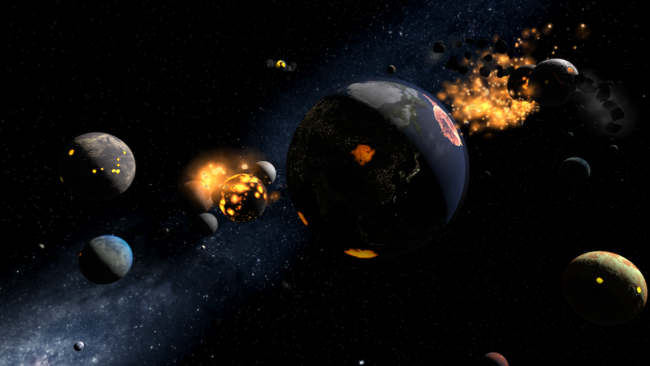
What’s Completed
At the beginning of this year, we shared Part I and Part II of our roadmap for 2017. We’ve now well past the halfway point, so it’s time for an update on what we’ve accomplished so far and we’ve got our sights set on for the rest of 2017 and into next year.
A New Foundation & VR 2.0 | Update 20
This was a big update for us, with a lot of important behind-the-scenes changes and a big list of VR improvements. Below are some of the highlights from this update; check out the Update 20 post for more information on how it’s paving the way for some bigger changes down the road.
- Rewritten, Scalable User Interface
- With our rewritten user interface, you can now scale the interface for smaller and larger resolutions.
- Future support for on-the-fly switching between multiple languages (see below).
- New Code Architecture
- A major reorganization that will make it easier for us to maintain our code, track down bugs, and develop and iterate on features.
- VR added Disintegration, Teleportation, and a Lot More
- Added all the new simulation features, improvements, and fixes from the Disintegration desktop updates, including…
- Tidal forces
- Improved explosions, and…
- New fragment and particle system
- A completely rewritten locomotion system for more responsive and smoother panning, scaling, and the all new rotation
- Teleportation! It’s never been easier to move from one planet to another
- Added all the new simulation features, improvements, and fixes from the Disintegration desktop updates, including…
Update 20 also included a long list of smaller improvements and bug fixes. And in the past couple of months since its release, we’ve pushed out smaller patches with many more bug fixes, plus the eclipse update below.
Solar Eclipse | Update 20.1
You probably heard about the August 21 solar eclipse that was visible from all of North America. We hope you were able to see it in person! But if you weren’t able to, or if you just want to see it over and over again now, then we’ve got just the simulation for you. See the Update 20.1 blog post for more info.
- August 21, 2017 Total Solar Eclipse Simulation
- Home > Open > Total Solar Eclipse on August 21, 2017
- A simulation of the Moon passing between the Sun and Earth and blocking out light across North America.
- Shadow Improvements
- Using past eclipse images as a guide, we’ve tweaked shadows just a bit to better capture Moon’s shadow on Earth.
- Advance Time Feature
- Introduced in 20.1.1, this feature allows you to run the sim until a specified length of time has passed. Just click the timer in the bottom bar to set a date or length of time then click Start!
What’s Coming Next
The following list is in a very rough order. These are all things we are working on currently, but when they’ll arrive is difficult to predict. If we had to guess when we’ll first start seeing them, we’d have to simply say “soon.”
Planet Grids
A debugging tool we are using to test the new planet grids. This tool shows how temperature is broken down into data points across the surface of the planet.
Planet Grids (previously called “automata”) is a new piece of tech that we’ve been working on for a while now that we’re very excited to introduce. The first stage of this tech allows us to simulate localized temperatures across surfaces, rather than an average temperature for the whole object. In turn, this will allow for much more dynamic and detailed visuals and simulation. This is also a crucial first step for another feature that’s long been coming…
Lasers
Lasers are fun for everyone! We’re very excited about introducing these, but it’s possible the community is even more excited. We don’t blame you. Good news: the laser is coming soon to the desktop version and will simultaneously return to VR with improved realism and functionality.
- From Laser Pointer to Planet Destroyer
- Set the power of the laser to go from a realistically-powered laser pointer to a laser far more powerful than anything ever produced, one capable of melting all of the ice off of Earth and heating it up to the point of complete vaporization.
Stellar Evolution
We unfortunately had to push this out of the Update 20 release because it simply took longer than expected and was not finished. The model itself is complete, but removing the old model and replacing it with the new is no simple task. Once we’ve got it plugged in, we’ll need to thoroughly test it to make sure that everything is in good shape and working as expected. This also is no simple task (there are many variables when it comes to testing stellar evolution in a universe simulator), but we’re definitely nearing completion.
- A Rewritten Model for the Life of a Star
- The new model supports 16 evolutionary star types versus the previous 5. It is primarily a function of mass and age or metallicity, and will work for evolutionary types outside of main-sequence stars.
- The results will be more dynamic and accurate properties for stars, as well as smoother transitions from type to type. It will also support mass loss from solar winds, and be able to differentiate envelope from core.
Steam Workshop
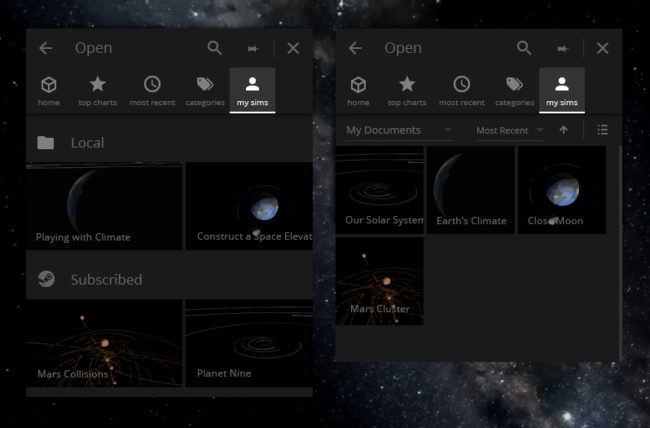
Early design mock-up of a new interface for with support for Steam Workshop simulations.
We’ve just begun work on adding Steam Workshop support to Universe Sandbox ². There’s plenty to do on the design front, and we have kinks to work out with our save & load system, but all things considered, we’re making good progress. Steam Workshop support is often requested by the community, and for good reason — we’re very excited to see what happens once it becomes easy to explore all of the simulations and scenarios the community is creating… and destroying.
- Share Simulations & Objects with the Whole Community
- Space may be a vacuum, but that doesn’t mean you should feel like you’re living in one in Universe Sandbox ². With support for Steam Workshop, you can easily browse, vote on, download, and explore community-created sims and objects, and of course upload your own for the whole community to check out.
- And Eventually, Share Models & Textures Too
- The first iteration will likely only support custom sims and saved objects, but in the future (see below) we plan to add support for custom models and textures as well.
Faster Physics & Performance
Thomas, our physics programmer, has made substantial upgrades to the physics code more times than we can count. But whatever number that is, add one more. We’re extremely grateful for every improvement, as physics is at the core of Universe Sandbox ², and making it faster means a lot more than just simply adding on a few FPS.
- Rewritten Physics Code
- A smoother user experience, more stable simulations at higher time steps, and more room for all of the big, new physics features we’re working toward, such as rigid body collisions, total body fragmentation, and space megastructures.
And Then Into 2018…
Localization
- Supported by New User Interface
- Now that our new user interface is in Universe Sandbox (Update 20), we’re ready to add the localization system.
- Community-Sourced Translations
- We plan to ask you, the community, for help in translating all of the text in Universe Sandbox ². We’re not certain how it will work yet, but our ideal system will let you click on any snippet of text from within Universe Sandbox ² and offer a translation or an improvement on an existing translation.
- Switch On-the-Fly Between Multiple Languages
- You’ll be able to switch at any moment between available translations. What is available depends on the community — as long as one user has offered translations, then it will be available for everyone to use and improve upon.
Custom Models
- Import Models & Textures Created by You or the Community
- This is in some ways the second big part of the Steam Workshop support. Being able to browse and download community-made models and textures which you can use in Universe Sandbox ² is going to help a lot with all of the requests we get for fictional and real spacecraft and planets. Of course, custom models means you can import whatever model you like (limited by file type), so if you’d prefer a cow over a rocket ship, then that’s okay too.
Rigid Body Collisions
- Bouncing and Breaking Apart Human Sized Objects
- Right now, human sized objects in Universe Sandbox ², like dice or bowling balls, will combine when they collide. Rigid body physics will make these collisions much more realistic, so they’ll instead “bounce” off of each other as you would expect them to.
- And Don’t Forget Stacking and Connecting
- Bouncing only makes sense some of the time for rigid body collisions. If you’re on the surface of a planet, for example, then you should also be able to stack these objects. Where does connecting come into this? Well, if you have rocket parts, then those should probably snap together… But we’re still far away from this.
Total Body Fragmentation
- Kaboom!
- With this new system, bodies will completely fragment when the force of a collision is strong enough. This should be most apparent when two equally sized bodies collide, as they should completely fragment apart instead of one “eating” the other, which currently happens.
More Advanced Planet Grids
- More Detailed and Responsive Planet Visuals & Interactions
- The first iteration of Planet Grids which is arriving along with lasers will help with temperature, but eventually the system will become more complex and allow for more advanced simulation, such as freeze heights, improved molten visualization, and…
- ???
- It’s hard to say what Planet Grids has in store for us next. Heat transfer between planetary layers? Life simulation? Maybe! We don’t have an exact plan, but we’re excited by all of the possibilities that open up with Planet Grids.
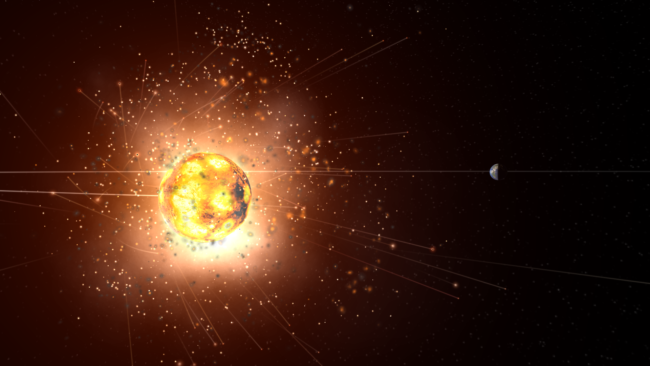
And Into the Distant Future
Mobile Version
- Universe Sandbox ² on Your Phone and Tablet
- Universe Sandbox ² is all about asking fantastical what-if questions. Well, what if you could simulate the universe on your phone? Our guess is you’d probably be pretty happy. At least, that’s what’s been proven true so far whenever we run a test build on our mobile devices. There are many user interface challenges still to solve, but we’re making good progress on this mobile version.
Space Megastructures
- Megastructures, But in Space
- We mention these a lot, even though they’re not on the immediate horizon, because they’re just that exciting to think about. Using physics-based space tethers as the idea behind the basic building block, these structures can come in many pre-defined shapes and sizes, and eventually support building custom structures.
- Think space elevators, Dyson spheres, and ring worlds. And then squeal with joy (and patience).
There isn’t a single item on this list that doesn’t get us excited. We’re happy with how far we’ve already come with Universe Sandbox ², and now we’re itching to see where these new features take us and our fans. There will soon be even more tools for creating and exploring whatever you can imagine, and you’ll have the ability to share these with the entire community, a community that will expand with localization and the mobile version. Many thanks to our ever-growing community of fans for all of your support.
For the latest Universe Sandbox ² news, follow us on Twitter and Facebook.
Total Solar Eclipse | Update 20.1
Aug 14th
August 28: Update 20.1.3 is a small update that adds a number of bug fixes and small improvements.
A solar eclipse occurs when the Moon passes between the Sun and the Earth, and partially or fully blocks the disk of the Sun. When it completely blocks the Sun, it is a total solar eclipse.
Total solar eclipses are rare events, happening about once every 18 months. But the opportunity to view them is even more rare; there is only a very narrow path across Earth from which they can be viewed.
On August 21, 2017, the continental United States will witness its first total solar eclipse in 38 years. Parts of 14 different states, from Lincoln City, Oregon to Charleston, South Carolina, will go dark as the Moon’s shadow passes over them.
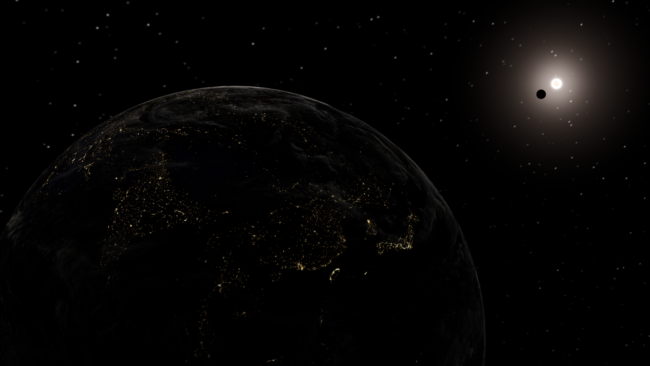
View the solar eclipse in Universe Sandbox ²:
Home > Open > Total Solar Eclipse on August 21, 2017
Home > Open > Total Solar Eclipse on August 21, 2017 – Close Up
Main Menu > August Eclipse (VR)
This update also includes a number of smaller improvements and bug fixes.
Check out the full list of What’s New.
For the latest Universe Sandbox ² news, follow us on Twitter and Facebook.
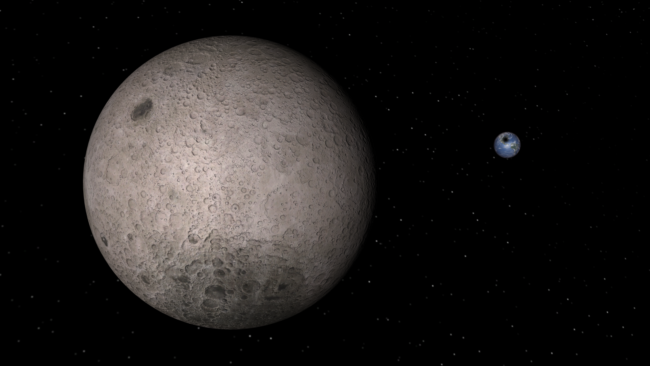
A New Foundation & VR 2.0 | Update 20 | Now Available
Jun 22nd
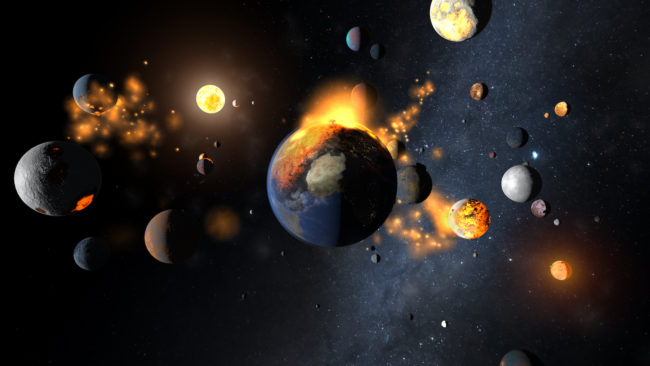
Run Steam to get Update 20, or buy Universe Sandbox ² via our website or the Steam Store.
This is an update for both the desktop and VR versions of Universe Sandbox ².
August 04: Update 20.0.16 is a small update with minor improvements and bug fixes.
A New Foundation
Imagine Universe Sandbox ² is a house that we’re building, and each update adds something new. Many of our updates so far have made fancy, noticeable additions to the house — a garage, a balcony, a new roof with some nice solar panels, etc. But with Update 20, we’ve completely lifted the house and made some major renovations to the foundation.
This means that there may not be many obviously big changes (unless you’re in VR! see below), but we’ve done considerable behind-the-scenes work. How much is “considerable,” you ask? In our task management system, we’ve closed over 560 tasks. That’s a lot. And for most of this work, the best sign that we’ve done our job well is if you can’t tell much of a difference.
But like a new foundation, these are very important changes which set us up for future features, improvements, and optimizations that would have been difficult or even impossible to implement with the old Universe Sandbox ² groundwork. (Or using another established metaphor: We have now paid off much of our technical debt which has accrued as our project continually evolves and heads further down roads no one has been down before.)
1. Rewritten User Interface
The rewritten interface in Update 20 is a big chunk of the new foundation for Universe Sandbox ². Currently, this is largely a behind-the-scenes change in the tech we’re using, but if you’re paying attention, you’ll notice some small changes to the design aesthetic as well.
There’s also a big change for users: You now have the ability to scale the interface. This was not possible with our old system. So if you’re running at a high resolution, like 4k, then no more squinting your eyes to see what exactly your exoplanet’s radius is! Our upcoming mobile version of Universe Sandbox ² also would not be possible without this scalable interface. And if that’s not enough, this new interface makes possible our plans to support on-the-fly switching between multiple languages.
Scalable Interface
Home > Settings > Set User Interface Scale
2. New Code Architecture
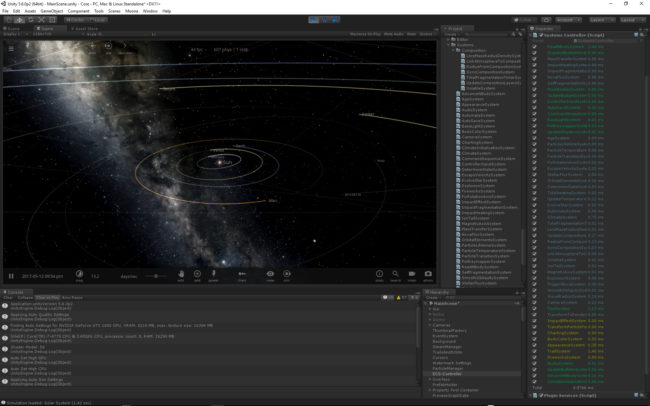
Our new code architecture in Update 20 is the other chunk of the replaced foundation. With this update, we’ve moved to a proper entity-component system, or ECS. Without getting too technical, this change is effectively a major reorganization that will make it easier for us to maintain our code, track down bugs, and develop and iterate on features.
Let’s compare our previous architecture to a tangled bundle of threads, where a system like temperature-control might twist and turn throughout and prove impossible to adjust or remove individually without messing with the rest of the bundle. With ECS, we’ve untangled and separated all the major systems which make Universe Sandbox ² run. Now we can take out a system, add a system, move a system around, whatever we like — the rest will remain intact.
The image above, taken in Unity, our development tool, shows a full list on the far right of our systems in place with ECS.
3. Disintegration, Teleportation, and a Lot More in VR
Update 20 VR is our first major VR update since we released it last year, and it’s a huge step up. First, it adds all the new simulation features, improvements, and fixes from the Disintegration desktop updates, including tidal forces, improved explosions, and the new fragment and particle system. There’s also a completely rewritten locomotion system for more responsive and smoother panning, scaling, and the all new rotation. To go along with this, there’s a new HUD interface that displays information automatically while scaling and rotating.
Make sure you check out the new Experience as well. The Experience will take you through a cinematic “What if…?” demonstration of Universe Sandbox ² VR.
Update 20 VR also marks the beginning of a unified Desktop/VR build, which will allow simulation improvements in the desktop version to be immediately available in the VR version as well. There is now also Save and Load support across Desktop and VR.
Teleportation
Tools > Teleport > Point at an object and pull trigger to instantly teleport to it
Rotation
Hold both grip buttons and move controllers around the center point between controllers
Experience
Menu (Vive) or B/Y (Rift) > Experience
4. Oculus Rift+Touch Support
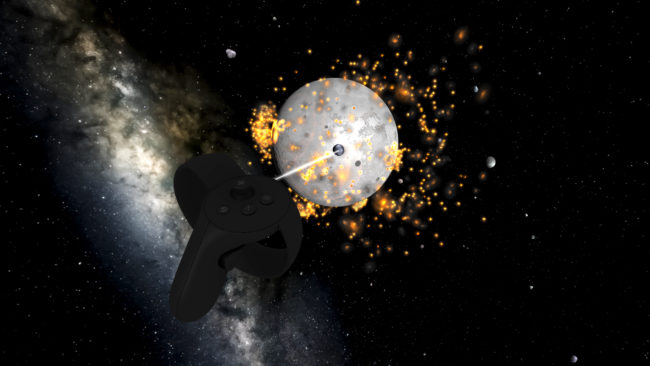
No need to explain this one. Unless you’re someone who owns an Oculus Rift+Touch and doesn’t yet own Universe Sandbox ². Then you’ll need to explain that one to your friends.
5. Dozens of Smaller Improvements and Fixes
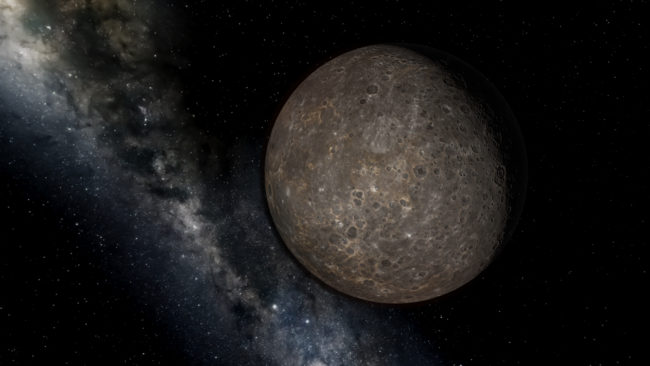
It wouldn’t be a big Universe Sandbox ² update without a pages-long list of improvements and bug fixes. Most notably, there’s a new Mercury texture, more cinematic control with camera smoothing and overlay settings, internal analytics, which will help us focus our efforts on making the best possible improvements to the user interface and user experience (these are anonymous; you may opt-out via Home > Settings > General > Allow Usage Statistics), a new Volume (quantity of space) property for objects, simulation stats for Mass Lost and Momentum Lost, and much more.
Camera Smoothing
Home > Settings > General > Camera Smoothing Multiplier
What’s coming next?
While these changes and new possibilities are exciting, we’re even more excited to move on to some big, new features again (it’s time for that indoor pool!). During our work on Update 20, we’ve made considerable progress on both planet-melting lasers and our rewritten stellar evolution model. They’re not ready for the spotlight just yet, but we’re now giving them our undivided attention. Also coming soon are some contributions to the improved foundation from Thomas, our physics programmer. His new physics system should introduce some substantial performance improvements as well as set the stage for rigid body collisions. Stay tuned!
Check out the full list of What’s New.
For the latest Universe Sandbox ² news, follow us on Twitter and Facebook.
Update 20 Patches
July 30: Updates 20.0.5-20.0.13 have fixed additional bugs with the user interface and simulation and added a warning message when the Time Step can no longer be increased.
June 26: Updates 20.0.1-20.0.4 have fixed the reported issues with the magnetic axis and magnetosphere, impact marks, clouds, database search in Add panel, and material cutaway
Voyager & Two Icy Moons | Alpha 19.7
Apr 19th
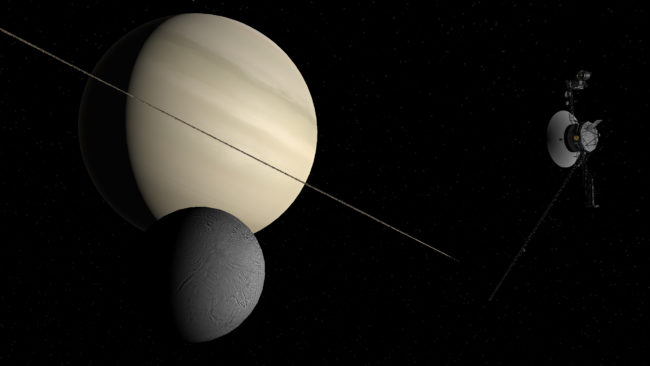
Alpha 19.7 is the last minor release before our next major planned update, Alpha 20, which has been in development since the beginning of the year.
Run Steam to update to Alpha 19.7, or buy Universe Sandbox ² via our website or the Steam Store.
In 1977, NASA launched the twin spacecraft Voyager 1 and 2 with the primary mission of exploring Jupiter and Saturn. The spacecraft sent back data and images that led to many discoveries about the two gas giants and their moons, rings, and magnetic fields. Then Voyager 2 went on to study Uranus and Neptune as Voyager 1 headed toward interstellar space. Today, the spacecraft continue to relay important scientific data as Voyager 2 explores the heliosheath and Voyager 1 heads farther than any human-made object in history.
Both Voyager 1 and 2 carry a copy of the famous “Golden Record.” These phonograph records contain a selection of images, sounds, and music meant to represent the breadth of life on Earth. As one of the curators for the record’s content, Carl Sagan noted, “The spacecraft will be encountered and the record played only if there are advanced spacefaring civilizations in interstellar space. But the launching of this bottle into the cosmic ocean says something very hopeful about life on this planet.”
Check out the new Voyager model and sims in Universe Sandbox ²:
Add > Objects > Voyager 1
Add > Objects > Voyager 2
Home > Open > Historical > Voyager 1 & Jupiter in 1979
Home > Open > Historical > Voyager 2 & Jupiter in 1979
Home > Open > Historical > Voyager 1 & Saturn in 1980
Home > Open > Historical > Voyager 2 & Saturn in 1981
Home > Open > Historical > Voyager 2 & Uranus in 1986
Home > Open > Historical > Voyager 2 & Neptune in 1989
Home > Open > Historical > Voyager 1 & 2 + Solar System in 2017

Another spacecraft, Cassini, entered Saturn’s orbit in 2004 to continue studying the planet and its moons. And on April 13, 2017, NASA announced that they found evidence in Cassini’s data for some of the ingredients for life on Saturn’s icy, ocean-bearing moon Enceladus. NASA will continue to study Enceladus and other “ocean worlds” in the ongoing search for signs of life beyond Earth.
Check out the new high-res texture for Enceladus:
Home > Open > Saturn & Moons
Add > Moons > Enceladus
Also included in 19.7 is a new high-res texture for Jupiter’s moon Callisto, along with a few small improvements and fixes.
Check out the full list of What’s New.
For the latest Universe Sandbox ² news, follow us on Twitter and Facebook.
Universe Sandbox ² 2017 Roadmap | Part II
Feb 27th
What’s Coming After Alpha 20?
In Part I of our 2017 Roadmap, we talked about what we accomplished in 2016 and about our next stop, Alpha 20. We hope to release Alpha 20 in the next few months, and we’re very excited to introduce the new stellar evolution, the reworked user interface, the analytics, and a few other changes. And then it’s time to set our sights forward again to all that lies beyond Alpha 20.
VR Update
Our new, dedicated VR developer, Jacob, has made good progress getting up to speed on our project and is already cranking out fixes and improvements for our VR experience. It’s been a while since we’ve been able to update the VR version, but we’re excited to bring it up to par again with the desktop version and introduce a few changes to the controls, interface, and introductory experience. If we’re lucky, this VR update may be paired with the Alpha 20 desktop update, but no promises.
Here’s what will hopefully be in our next VR update:
- Updated to Alpha 19
- Alpha 19 added some big simulation features which are currently missing in the VR version, like tidal forces, reworked explosions, new volatile effects like vaporized planets, more variety in supernovae, and greatly improved appearance and performance for particles and fragments. Alpha 19 was a huge update, and we’re excited to bring that to VR users.
- New tutorials
- One piece of feedback we see the most on our VR mode is that there’s not enough guidance, and the controls can be a little unwieldy. We’ve had some bigger ideas about redesigning the controls and interface, but these changes will be a longer project for another day. Until then, we’ve been tightening up the current controls, tweaking the interface, and adding some introductory experiences, all of which should help a lot in orienting new users and making for a smoother and more intuitive experience.
- Official Oculus Touch support
- Technically, anyone with an Oculus Rift and the Touch controllers can already play Universe Sandbox ² VR without any issue, the only noticeable difference is that the in-game controller models are Vive controllers instead of Touch. But this update will address this difference and add a few other small compatibility changes in order to officially support Touch. We also plan on adding Universe Sandbox ² VR to the official Oculus Store.
Then after this update, we’ll be looking at bigger design changes, like adding more interactive tools and accompanying custom controller models, to make the VR experience even more impressive and compelling. Below is a screenshot of some concept art for what a planet gun might look like in VR, designed by Nikita Replyanski. Please note that this is very early concept art and does not necessarily reflect what will be in Universe Sandbox ².
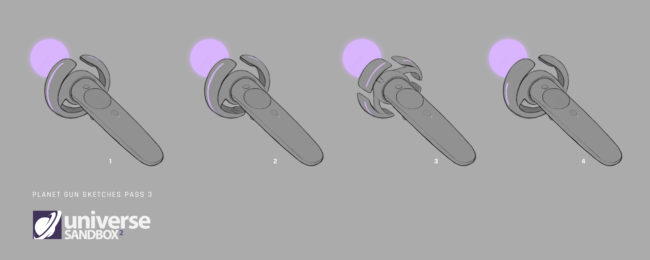
Alpha 21 & Beyond
This is where our list of future improvements and features becomes a little less concerned with order and time. We can’t say with much certainty which will be arriving first, or which will be bundled in this update or that update. But we can say with a lot of certainty that we’re very excited for all of these changes, and we believe each will add a new element to the Universe Sandbox ² experience. Many of these are big projects, but as mentioned in Part I of our roadmap, we hope to keep these projects less intertwined than in the past. This will hopefully allow us to roll out these changes as they’re individually ready and stick to a more frequent and regular release schedule. Please note that none of the following are guaranteed to happen in 2017, but we should see a number of them this year.
More Likely to Arrive First
- New Native (Better, Faster, Stronger Physics)
- Thomas, our lead physics developer, is once again revamping the physics system in Universe Sandbox ². You can expect better overall performance, faster simulations, and greater accuracy.
- Second Stage of Planetary Grids/Detail/Automata
- As mentioned in Part I, this isn’t a single feature, but rather a system that will open up the doors for a bunch of features that will make planets visually more detailed and responsive to interactions. The first stage was simply some movement behind the scenes, but this second stage will introduce some visible changes for users.
- This system works by increasing the spatial resolution of data. Instead of having one point of data for an object’s property, like temperature, there will now be a 2D grid of data. With temperature, for example, this means that collisions can impact values locally, so heat spreads from the impact site rather than just raising the overall temperature. This can also help with more accurate volatiles, tidal heating, tidal locking, and can also factor in elevation.
- New Sound Effects!
- We’re now working with the sound design team, A Shell in the Pit (whose credits include work on Fantastic Contraption, Parkitect, and many other great titles) to produce brand new sound effects for Universe Sandbox ². First on the list will likely be collision sound effects and user interface sounds. It’s quite the design challenge, as they’ll have to account for things like changes in the time step and sounds for which there is no real-world equivalent… what exactly should a pulsar sound like?
- Galaxies
- We know that galaxies in Universe Sandbox ² could use some love, and we plan to give them the love they deserve soon. Their overall appearance will get an overhaul, and they’ll no longer resemble jumbled, generic galaxies.
A pulsar in Universe Sandbox ².
More Likely to Arrive Later
- Total Body Fragmentation
- Pretty self-explanatory: with this new system, bodies will completely fragment when the force of a collision is strong enough. This should be most apparent when two equally sized bodies collide, as they should completely fragment apart instead of one “eating” the other, which currently happens. Our physics developer will begin work on this again after finishing the New Native described above.
- Third Stage of Planetary Grids/Detail/Automata
- Heat transfer between planetary layers? Life simulation? Maybe! We don’t have an exact plan for where this system will take us after stage two, but we’re excited to find out.
- Mobile Version
- Sure it’s cool playing Universe Sandbox ² at your desk, but what if you could simulate the universe on your phone that you just pulled out of your pocket? And then with a tap of your finger you send a black hole careening past the sun, putting our whole solar system in galactic jeopardy? All while waiting for the bus to arrive? Yeah that sounds pretty cool, too. And with the processing power of modern phones and tablets, it’s not as far-fetched as you may think. In fact, we already have a version up and running on some of our phones. There’s still a lot of work to do on optimizing for performance and controls, but we’re making good progress.
- Steam Workshop & Custom Models
- Sharing is caring. Of course, your carefully crafted custom solar system still exists even if you’re the only one looking at it, but wouldn’t it be more fun to share it with thousands of other Universe Sandbox ² fans? You can already manually share these files, but we want to support seamless sharing and browsing of custom simulations and bodies using Steam Workshop. Combine this with support for importing your own models and suddenly you have access to whatever planets, stars, and spaceships our passionate and talented community dreams of.
- Rigid Body Collision System
- If you’ve ever collided a bowling ball with some dice in Universe Sandbox ², you know that they just merge with each other, and if you’ve ever seen these collide in real life, you know that’s not entirely realistic behavior. That’s why our new physics developer, Rahul, is working on the solution to this exact problem. Then it’s onto other areas of rigid body physics, like constraints, stacking, and collapse, which paves the way for space megastructures and even pilotable spaceships.
- Constellations
- Universe Sandbox ² isn’t designed as planetarium software, but we agree that being able to view constellations can be fun and educational, especially when paired with a sandbox environment. It’s an often requested feature that hasn’t made its way over yet from Universe Sandbox Legacy, but we plan to devote some time to this for a future update.
- Atmospheric Scattering
- Sunrises and sunsets are universally loved, whether your planet orbits one star or five. Wouldn’t it be great to see them in Universe Sandbox ² when standing on the surface of your planet? This is where something called atmospheric scattering comes in. We teased this a long time ago with a demo video, but it only existed as a project separate from Universe Sandbox ². We still plan to implement this eventually, as it certainly adds a small but dramatic touch to the surface view.
Jupiter orbiting Wolf 359 in Universe Sandbox ².
And Then Even Later…
- Spaceships
- Yes, we mentioned “pilotable spaceships” above, but remember that rigid body physics are only a step toward these and they are still a long way off. Doesn’t mean we’re not completely in love with the idea and already looking forward to the possibility!
- Space Mega Structures
- Using physics-based space tethers as the idea behind the basic building block, these structures can come in many pre-defined shapes and sizes, and eventually support custom building. Think space elevators, Dyson spheres, and ring worlds. Then just attach a ridiculously overpowered laser, and you’ve got yourself a DIY Death Star. There’s still a lot to do to get these running smoothly in a simulation, but the above-mentioned work on rigid body physics will help us get there.
- Procedurally Generated Planetary Surfaces
- Users often tell us they want to see more details when entering surface cam (select a body and press “C” to enter surface cam). Once implemented, this will be a great answer to that request. Instead of relying on a small number of hand-crafted textures, planetary surfaces could instead be procedurally, randomly generated, resulting in an endless variety of surfaces with a dynamic range of detail. This is just in the idea phase right now; we have not begun work on it yet, and it won’t be a quick project. But we know that it could add another level of immersion and realism to Universe Sandbox ² and be a fan-favorite.
Excited? As we’ve said many times, so are we. Thank you for your never-ending support, and thank you for your patience as we continue to build the universe.
For the latest Universe Sandbox ² news, follow us on Twitter and Facebook.
TRAPPIST-1 & the Seven Planets | Alpha 19.6
Feb 23rd

Run Steam to update to Alpha 19.6, or buy Universe Sandbox ² via our website or the Steam Store.
Welcome, TRAPPIST-1 system! NASA announced yesterday the discovery of seven Earth-sized planets orbiting the ultra-cool dwarf star, TRAPPIST-1.
Check out the new simulation of the TRAPPIST-1 system in Universe Sandbox ²:
Home > Open > Core tab > TRAPPIST-1
Three of the seven planets are within the star’s habitable zone, which means that they are in an area where rocky planets have the highest likelihood of having liquid water. This also means that they have a chance of supporting life as we know it.
The TRAPPIST-1 system is relatively close to us at about 40 light-years from Earth. It is named after The Transiting Planets and Planetesimals Small Telescope (TRAPPIST) in Chile, which discovered three of the planets announced in May 2016. Then in the fall of 2016, NASA’s Spitzer Space Telescope observed TRAPPIST-1 for 500 continuous hours, confirming the original discovery and uncovering the rest of the seven planets. This is the greatest number of potentially habitable planets ever discovered around a single star.
All seven of the planets have orbits closer to their star than Mercury is to the Sun. Scientists suspect that, because of these tight orbits, they are all likely tidally-locked, as well. This means that the same side of the planet always faces the star, just as one side of the Moon always faces the Earth. But despite this proximity and being tidally-locked, they all have a chance of harboring liquid water due to the parent star’s very low temperature. Scientists say this system is a promising place to search for life, and they will continue to observe the system and its planets.
Check out the full list of What’s New.
For the latest Universe Sandbox ² news, follow us on Twitter and Facebook.
